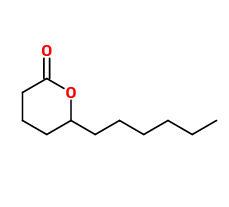
Photo credits: ScenTree SAS
Do you sell any of the raw materials? Would you like to let our users know?
Send an email to fournisseurs@scentree.coto learn about our advertising opportunities.
Do you sell any of the raw materials? Would you like to let our users know?
Send an email to fournisseurs@scentree.coto learn about our advertising opportunities.
General Presentation
-
CAS N° : 710-04-3
-
EINECS number : 211-915-1
-
FEMA number : 3294
-
Density : 0,958
-
Optical rotation : Donnée indisponible
-
Allergens : This ingredient does not contain any allergen.
-
Refractive Index @20°C : Donnée indisponible
-
Volatility : Base
-
Price Range : €€€€
-
Appearance : Colorless liquid
-
FLAVIS number : 10.011
-
JECFA number : 234
Information on synthetic ingredients
-
Acid Value : Donnée indisponible
-
Boiling Point : 298,4°C
-
Detection Threshold : Donnée indisponible.
-
Molecular formula : C11H20O2
-
Log P : 3,06
-
Molecular Weight : 184,28 g/mol
-
Fusion Point : Donnée indisponible.
-
Flash Point : 155°C
-
Vapor pressure : Donnée indisponible
Uses
Other comments :
Stability :
Lactones tend to polymerize through time, making them more viscous and leading to a phase shift in alcohol.
Uses in perfumery :
Used to bring creamy facets to reconstituted vanilla, coconut or gardenia.
Year of discovery :
Data not available.
Isomerism :
Delta-Undecalactone has an asymetric carbon. Nevertheless, we always use its racemic mixture in perfumery. Delta-Undecalactone is an isomer of C14 Aldehyde, which has one less carbon atom into its ring, but one more in its ramified carbon chain. The resulting odor changes from a metallic peach and coconut odor to a fruity peach odor
Synthesis precursor :
Delta-Undecalactone is not a precursor to the synthesis of another compound of olfactory interest.
Natural availability :
Data not available.
Synthesis route :
Delta-Undecalactone can be synthesized by an oxidation reaction of 2-hexylcyclopentanone, using a peracid.
Regulations & IFRA
This ingredient is not restricted

